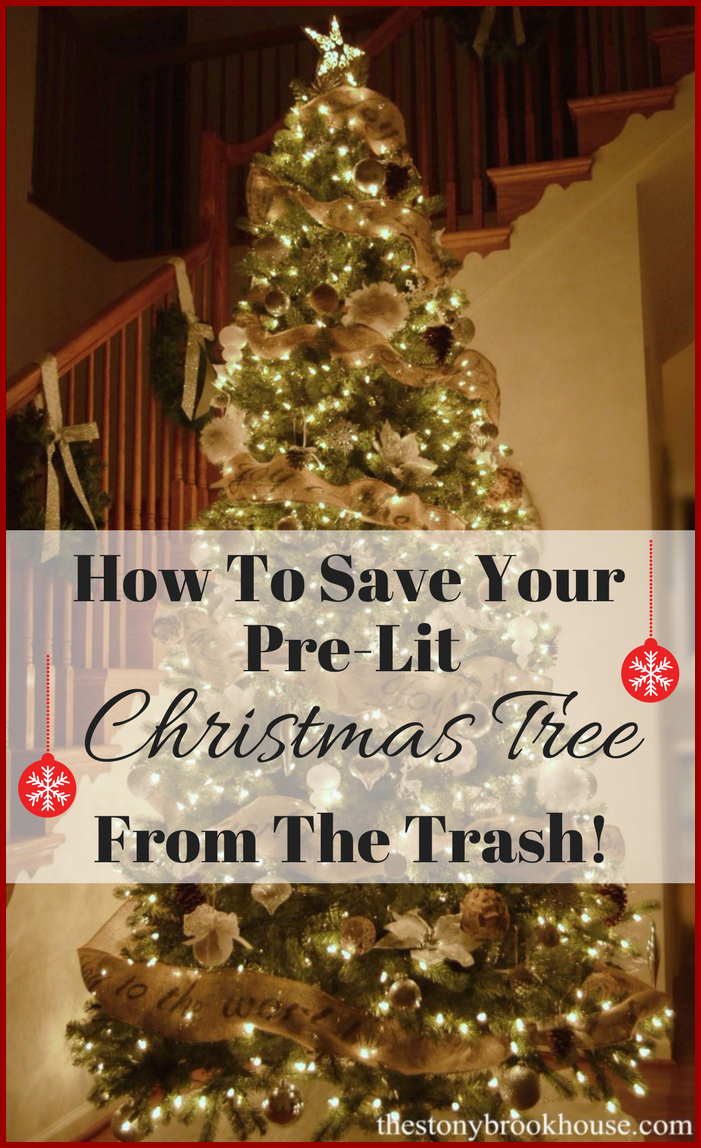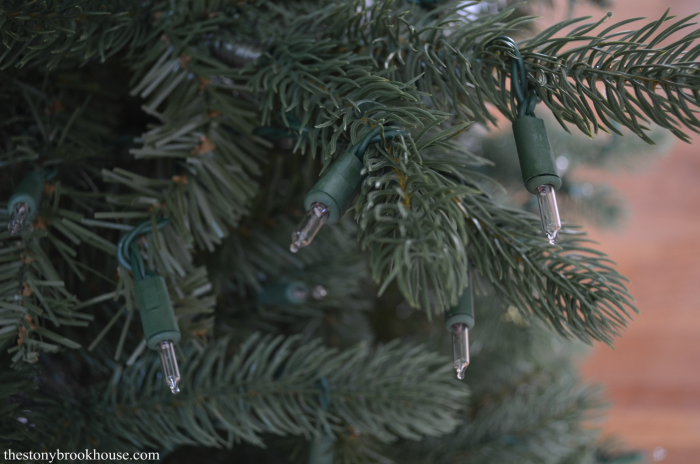This post may contain affiliate links, meaning I get a commission if you decide to purchase through my links, at no additional cost to you. As an Amazon Associate, I earn a few pennies from qualifying purchases.
I was this close to throwing my pre-lit Christmas Tree in the trash! Those dag-gum lights! Seriously! 😞
But we saved it!! Yay!😀 I discovered the answer, after searching LONG and HARD on Google and YouTube.
Disclaimer: Hubby and I are not electricians. We are not here claiming we have knowledge of electricity. This is just a tip we found that worked for us. We do not guarantee that this will fix your Christmas tree.... but it might!
That little tool is awesome and has made fixing some of the light issues soooo much easier!! You can test light strands for power, test light bulbs, and so much more!! One of the best $20 we've spent!
HOWEVER.... this year we had a whole NEW set of problems.... I seriously was at my wits end. Whole sections were out! What? 😤 😣 😵 And I'll show you the culprit!
Our Christmas tree has a little light called a current resistor bulb. It looks different than all the other lights on the tree. Do you see how the base of the bulb is white? On some trees, I've heard they can be black.
Most of your lights will be green, like these.
When that current resistor bulb goes out, the lights following it have no power. Somehow, when that light is burnt out it stops the flow of electricity. Anyway, that light bulb needs to be changed.
But! GE glued that baby in and gave no lip to pry it out or anything! Really??? What?? Is your Christmas Tree done then?? I think that really stinks. I would've thought that GE would have done a better job. But we all know it's about the $$. They don't want your tree lasting forever!
So, I watched this guy on You Tube. Click HERE to see it.
Basically, Hubby took an Exacto knife and carefully cut a bit of green off around the top edge of the bulb. ( The guy in the video used a Dremel, either way it gets the job done.)
Now, that the white bulb base is exposed, you can grab it and wiggle it loose. It might get a bit mangled using needle nose pliers, but that's fine. Remember, they are probably glued, so it takes a bit of work to loosen it.
When it's loose, take it out.
The white bulb base looked very similar to the other light bulbs on the tree. The easy part is next.
Just replace the bulb. 😊 Then replace the light bulb base back into the light strand.
Yay! We didn't have to toss the tree!
Here's a tip we learned. Every year be diligent about replacing burned out light bulbs. That keeps the current resistor bulb from burning out. Now we're pros at replacing light bulbs and that Light Keeper Pro helps a TON!
I really hopes this helps some of you!
Blessings!











I hate pre lit trees because this happens all the time. I always add a few more light sets to the pre lit trees that I have since the rule is usually at least 100 lights per foot, pre lit trees seldom come with enough lights on them. Many of the trees that I have (Total of over 20 this year) had their lights die out so I just cut them all off the Tree and lit them myself which was more to my liking anyway. I prefer not to have pre lit Trees...
ReplyDeleteHugs,
Deb
Hi Debbie!! Yes, I'm leaning towards your way no more pre-lit! But... I'm thinking the LED ones might be the answer?? Whoa! 20 trees?? I bet it's beautiful! I'm going to head over to your blog and take a looksee! :)
DeleteHi good post. When using the light keeper pro did the bulb next to the current resistor bulb showing as if it had current?
ReplyDeleteYes, it did! One side had power, and the other side did not. Thanks for stopping by! :)
DeleteTried this but it didn't fix ours. The lightkeeper pro is indicating I need to use the tool to fix the shunt but the base is too big to use it on. May have to modify the lightkeeper pro or cut the light out and rewire it. It beeps on one side (power in) but no beep on the other side (no power).
DeleteUgh! What a bummer! Lighted trees... I have a love/hate relationship with them...
DeleteI have the same problem. Nearly all the resistor bulbs are burnt out. I took the tool you suggested buying, located the next bulb AFTER the resistor bulb. Then I plugged in the LIGHT KEEPER PRO and fired the trigger two or three times and the lights came back on, MINUS the resistor one. THANK YOU for the tip on how to remove them. Once the strand lights up, find and replace the rest of the bulbs that are out in that section as well!
ReplyDeleteAwesome! So glad I could help!! Merry Christmas!
DeleteI identified the resistor bulbs before seeing this, but the BULB of mine is glued into its base!! I can pop it out but can’t replace the bulb because of the glue. :(
ReplyDeleteThis comment has been removed by a blog administrator.
ReplyDeletePeople don't understand how the light keeper tool works. If there is a shunt problem, the problem is with the bulb itself, not the socket. That's what's nice about the tool, you don't need to take out or find the exact problem bulb. you plug the tool into ANY socket in the unlit section and pull the trigger a few times. When it doesn't work, you should also keep an eye out for sparks in any bulbs, which indicates a short and swap out the sparking bulb
ReplyDeleteThanks so much for the info how to remove the white resister bulb base! So frustrating that it was glued in, but cutting back the top edge just a little with xacto blade worked perfectly to remove it & replace the bulb. Also checked all the fuses, replaced the ones that were bad. Replaced all the bulbs that were burnt out (discolored blackish shade). Used the Lightkeeper Pro tool in the empty resister socket before replacing the new bulb. Prelit tree now sparkles like new again!!
ReplyDeleteAll the lights on the string have what is called a shunt wrapping on the filament wires. If the bulb burns out, the filament wires bend out and the shunt shorts out the filament wires. (The bulb goes dark, but the shunt carries the current down the string.), If too many bulbs are shunted, the rest of the string gets too much voltage and very quickly, the rest of the string will blow every bulb in the string. The Resister bulb is the only one without the shunt, So when it goes, all the bulbs go out (it actually protects the rest of the string from burning out. This is a great idea, but I could not find a source of resister bulbs without shunts. So if you replace the resistor bulb. Make sure that you carefully inspect your string and replace every dark bulb, or within a day or so, you will have all the string blown. From what I can read, if you lose about 3-4 bulbs, the rest will go in about 1 week.
ReplyDeleteThe resistor bulb is a special sort of light bulb that acts as a fuse to protect your light string from losing all the bulbs. They are also referred to as current limiting bulbs. (but they are typically the only ones with a white base). Most incandescent decorative light strings use shunted bulbs. (The resistor bulb is the only bulb that is NOT shunted). The shunted bulbs have a conductor wrapped around the base of the filament wires. When the bulb burns out the filament wires come apart, and touch the shunt. This allows the current to flow through the shunt wires, to the rest of the light string, and that bulb goes dark. This is great and prevents one light from taking down the entire string. But the problem is that if too many shunts are activated as other bulbs burn out, it wont take long till the entire string is gone, and they will all blow at one time. So the purpose of the resistor bulb is to take down the entire string BEFORE too many bulbs are shunted.
ReplyDeleteThis is great but the problem is, I cannot find a source for the resistor or current limiting bulbs. So if you replace it with a standard (shunted) bulb, Be absolutely certain to make sure you find every other bad bulb and replace it. Otherwise within a few days or weeks, your entire string will be blown, and you will have to replace every single bulb. The key is to never ignore a single burnt out bulb. Replace it immediatly, and inspect often. especially if you replaced the resistor bulb with a standard bulb.